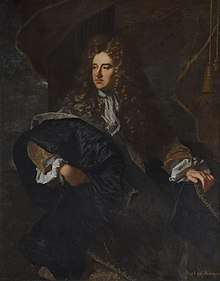Edward Villiers, 1st Earl of Jersey
Edward Villiers, 1st Earl of Jersey (c. 1656 – 25 August 1711) was an English peer, courtier, and statesman of the Villiers family. He was created Baron Villiers and Viscount Villiers in 1691 and Earl of Jersey in 1697.
Edward Villiers | |
|---|---|
| 1st Earl of Jersey | |
 | |
| Born | c. 1656 Kingdom of England |
| Died | 25 August, 1711 (aged 54–55) Kingdom of England |
| Father | Sir Edward Villiers |
| Mother | Frances Howard |
| Occupation | Peer, landowner, and statesman |
Origins
He was the son of Sir Edward Villiers (1620–1689) of Richmond, Surrey, by his wife Frances Howard, the youngest daughter of Theophilus Howard, 2nd Earl of Suffolk and Elizabeth Home.
His grandfather was Sir Edward Villiers (c. 1585–1626), Master of the Mint and Lord President of Munster who was half brother of George Villiers, 1st Duke of Buckingham and of Christopher Villiers, 1st Earl of Anglesey. His sister was Elizabeth Villiers, the mistress of King William III, and was later Countess of Orkney as the wife of George Hamilton, 1st Earl of Orkney.[1]
Education
He was admitted to St John's College, Cambridge in 1671.[2]
Career
Villiers was Knight Marshal to the royal household in succession to his father. He was Master of the Horse to Queen Mary II and was Lord Chamberlain to King William III and to Queen Anne. In 1696 he represented his country at the Congress of Ryswick. He was ambassador at The Hague and after his elevation to the peerage (1697) was ambassador in Paris. In 1699 he was made Secretary of State for the Southern Department, and on three occasions he was one of the Lords Justices of England. In 1704 he was dismissed from office by Queen Anne, after which he was involved in some of the Jacobite schemes.[1]
Marriage and children
On 17 December 1681 he married Barbara Chiffinch (1663 – before 13 December 1735), daughter of William Chiffinch (1602–1688). By her he had two sons and a daughter:
- William Villiers, 2nd Earl of Jersey (c. 1682 – 13 July 1721)
- Henry Villiers (died 1743)
- Mary Villiers (died 17 Jan 1734/35), who married twice:
- Firstly to Thomas Thynne (died 1710) son of Henry Frederick Thynne and Dorothy Philips, whom she bore a son: Thomas Thynne, 2nd Viscount Weymouth.
- Secondly in 1711 she married George Granville, 1st Baron Lansdowne (1666–1735), without sons.
Death
He died on 25 August 1711 of apoplexy.[3]
References
-

- "Villiers, Edward (VLRS670E)". A Cambridge Alumni Database. University of Cambridge.
- Abel Boyer. The history of the reign of Queen Anne. 10. p. 382.
- . Dictionary of National Biography. London: Smith, Elder & Co. 1885–1900.
| Political offices | ||
|---|---|---|
| Preceded by James Vernon |
Secretary of State for the Southern Department 1699–1700 |
Succeeded by James Vernon |
| Preceded by The Duke of Shrewsbury |
Lord Chamberlain 1700–1704 |
Succeeded by The Earl of Kent |
| Diplomatic posts | ||
| Preceded by The Earl of Portland |
English Ambassador to France 1698–1699 |
Succeeded by The Earl of Manchester |
| Peerage of England | ||
| New creation | Earl of Jersey 1697–1711 |
Succeeded by William Villiers |
| Viscount Villiers 1691–1711 | ||